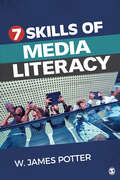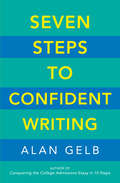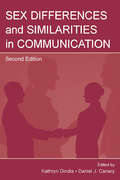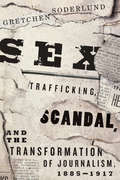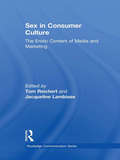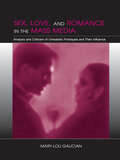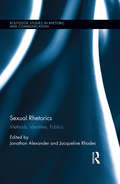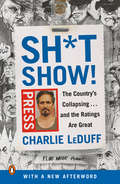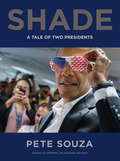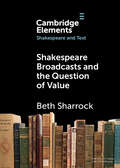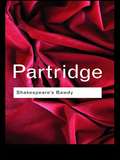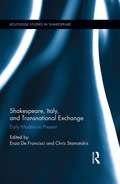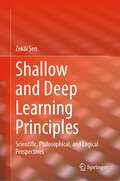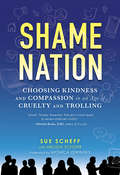- Table View
- List View
Seven Skills of Media Literacy
by W. James PotterIn Seven Skills of Media Literacy, best-selling author and renowned scholar W. James Potter provides readers with the practical guidance they need to make substantial improvements on seven major skills required to increase their media literacy. For each of these seven skills, Potter provides easy-to-follow algorithms and heuristics that structure the process of using the skill. Chapters also offer many exercises to help readers practice using these algorithms and heuristics while avoiding traps in thinking. The book is organized to guide readers progressively through the sequence of media literacy skills, starting with the most fundamental and building to the more complex skills. This book is a must read for those people serious about becoming more strategic in using the media to satisfy their own needs for information and entertainment and thereby avoid being exploited by media messages.
Seven Skills of Media Literacy
by W. James PotterIn Seven Skills of Media Literacy, best-selling author and renowned scholar W. James Potter provides readers with the practical guidance they need to make substantial improvements on seven major skills required to increase their media literacy. For each of these seven skills, Potter provides easy-to-follow algorithms and heuristics that structure the process of using the skill. Chapters also offer many exercises to help readers practice using these algorithms and heuristics while avoiding traps in thinking. The book is organized to guide readers progressively through the sequence of media literacy skills, starting with the most fundamental and building to the more complex skills. This book is a must read for those people serious about becoming more strategic in using the media to satisfy their own needs for information and entertainment and thereby avoid being exploited by media messages.
Seven Steps to Confident Writing
by Alan GelbNot everyone is a natural writer. In fact, most people don&’t think that much about writing until they&’re called upon to write something like an office memo or a wedding speech and find themselves paralyzed with self-doubt. Author and writing coach Alan Gelb specializes in helping anxious writers find their voice, drawing upon techniques that can improve anyone&’s writing, sometimes in a matter of days. His compact and easy-to-use guide demystifies the writing process and shows readers how to sculpt concise sentences, shape well-structured paragraphs, polish a final draft, and combat procrastination. Best of all, readers will see for themselves that writing is not an inborn talent but a skill that can be mastered with a bit of patience and perseverance.
Sex Differences and Similarities in Communication (Routledge Communication Series)
by Daniel J. Canary Kathryn DindiaSex Differences and Similarities in Communication offers a thorough exploration of sex differences in how men and women communicate, set within the context of sex similarities, offering a balanced examination of the topic. The contents of this distinctive volume frame the conversation regarding the extent to which sex differences are found in social behavior, and emphasize different theoretical perspectives on the topic. Chapter contributors examine how sex differences and similarities can be seen in various verbal and nonverbal communicative behaviors across contexts, and focus on communication behavior in romantic relationships. The work included here represents recent research on the topic across various disciplines, including communication, social psychology, sociology, linguistics, and organizational behavior, by scholars well-known for their work in this area. In this second edition, some chapters present new perspectives on sex/gender and communication; others present substantially revised versions of earlier chapters. All chapters have a stronger theoretical orientation and are based on a wider range of empirical data than those in the first edition. Readers in communication, social psychology, relationships, and related fields will find much of interest in this second edition. The volume will serve as a text for students in advanced coursework as well as a reference for practitioners interested in research-based conclusions regarding sex differences in communicative behavior.
Sex Trafficking, Scandal, and the Transformation of Journalism, 1885-1917
by Gretchen SoderlundDuring the first half of the nineteenth century, the penny presses of the industrial East treated brothels as a mundane, if annoying, aspect of city life. But later in the century, reformers and mainstream papers began to push back against this representation through highly public campaigns against "white slavery. " These newspaper crusades mixed a potent cocktail of lurid sexual detail and sensationalist scandal aimed equally at promoting anti-vice measures, arousing popular demand for progressive reform, and increasing newspaper circulation. In Sex Trafficking, Scandal, and the Transformation of Journalism, Gretchen Soderlund offers a new way to understand sensationalism in both newspapers and reform movements. By tracing the history of high-profile print exposés on sex trafficking by journalists like William T. Stead and George Kibbe Turner, Soderlund demonstrates how controversies over gender, race, and sexuality were central to the shift from sensationalism to objectivity--and crucial to the development of journalism in the early twentieth century.
Sex in Consumer Culture: The Erotic Content of Media and Marketing (Routledge Communication Series)
by Tom Reichert Jacqueline LambiaseSex in Consumer Culture: The Erotic Content of Media and Marketing considers the use of sex to promote brands, magazines, video games, TV programming, music, and movies. Offering both quantitative and qualitative perspectives from leading scholars in a variety of disciplines, this volume addresses a range of integral issues such as media promotion, racial representations, appeals to gay and lesbian communities, content analyses, and case studies. Chapters represent diverse perspectives, addressing such questions as:*What happens when sexual content created for adults reaches children?*What meaning do sexual words and images have within the contexts of sporting events, trade shows, video games, personal ads, or consumer Web sites?*What effects might sex-tinged images have on audiences, and where should the focus be for new effects research?*Where are the current boundaries between pornography and mainstream sexual depictions?Exploring sexual information as it is used in mass media to sell products and programs, Sex in Consumer Culture is an important collection, and it will be of great interest for scholars and students in advertising, marketing, media promotion, persuasion, mass communication & society, and gender studies.
Sex in Imagined Spaces: Gender and Utopia from More to Bloch
by Caitriona DhuillFrom Thomas More onwards, writers of utopias have constructed alternative models of society as a way of commenting critically on existing social orders. In the utopian alternative, the sex-gender system of the contemporary society may be either reproduced or radically re-organised. Reading utopian writing as a dialogue between reality and possibility, this study examines the relationship between historical sex-gender systems and those envisioned by utopian texts. Surveying a broad range of utopian writing from the nineteenth and twentieth centuries, including Huxley, Zamyatin, Wedekind, Hauptmann, and Charlotte Perkins Gilman, this book reveals the variety and complexity of approaches to re-arranging gender, and locates these 're-arrangements' within contemporary debates on sex and reproduction, masculinity and femininity, desire, taboo and family structure. These issues occupy a position of central importance in the dialogue between utopian imagination and anti-utopian thought which culminates in the great dystopias of the twentieth century and the postmodern re-invention of utopia.
Sex, Love, and Romance in the Mass Media: Analysis and Criticism of Unrealistic Portrayals and Their Influence (Routledge Communication Series)
by Mary-Lou GalicianThis accessible yet research-based text offers both foundational theories and practical applications of analysis and criticism of mass media portrayals of sex, love, and romance in a wide variety of mass media, from entertainment to advertising to news. The multidisciplinary methodological perspective comes out of a media literacy approach and embraces a variety of traditions along the quantitative-qualitative continuum. Focused on portrayals of male-female coupleship, the book is centered around the 12 major myths and stereotypes of Galician's Dr. FUN!'s Mass Media Love Quiz©, each of which has a corresponding Dr. Galician Prescription® that encapsulates healthy strategies--rarely found in the mass media--to counteract that myth or stereotype. Readers learn how to identify, illustrate, deconstruct, evaluate, and reframe the mass media's mythic and stereotypic portrayals of sex, love, and romance. They also learn how to use their own formal critical evaluations to clarify their own values and--as media consumers or mass communication creators--to share their insights with others. Thus, the learning objectives encompass all three major educational domains: cognitive, affective, and behavioral. Part I of this book covers the five foundations: *myths and stereotypes of love and coupleship;*models of realistic and constructive love and coupleship;*mass media storytelling approaches, techniques, and devices;*research and theories of mass media effects; and*strategies and skills of media literacy. Part II is devoted to exploring the myths and stereotypes identified in the Quiz. Following several brief case studies and a summary of related research and commentary, each chapter focuses on analyses and criticisms of portrayals of sex, love, and romance in the content of news and advertising, as well as entertainment using Galician's Seven-Step Dis-illusioning Directions. Each chapter concludes with a "Dis-illusion Digest."While critical of unrealistic portrayals and the damage they can cause unsuspecting media consumers, Galician--a media literacy advocate--is not anti-media. Rather, her goal is to empower consumers to use these portrayals with more awareness of their possible consequences, to resist adopting them as models for actual behavior, and to consciously reframe them into more realistic, productive scenarios. This unique text is an engaging classroom resource for media literacy, media and relationships, and media and society coursework.
Sexual Rhetorics: Methods, Identities, Publics (Routledge Studies in Rhetoric and Communication)
by Jonathan Alexander Jacqueline RhodesSexual rhetoric is the self-conscious and critical engagement with discourses of sexuality that exposes both their naturalization and their queering, their torquing to create different or counter-discourses, giving voice and agency to multiple and complex sexual experiences. This volume explores the intersection of rhetoric and sexuality through the varieties of methods available in the fields of rhetoric and writing studies, including case studies, theoretical questioning, ethnographies, or close (and distant) readings of "texts" that help us think through the rhetorical force of sexuality and the sexual force of rhetoric.
Sexual Teens, Sexual Media: Investigating Media's Influence on Adolescent Sexuality (Routledge Communication Series)
by Kim Walsh-Childers Jane D. Brown Jeanne R. SteeleThis collection explores the sexual content of U.S. mass media and its influence in the lives of adolescents. Contributors address the topic of sexuality broadly, including evidence not only about physical sex acts, but also about the role the media play in the development of gender roles, standards of beauty, courtship, and relationship norms. Chapters included here present new perspectives on what teens are paying attention to in the media, and offer insight into how teens are understanding and applying what the media present about sex and sexuality. Employing various methodological approaches, the studies also represent a diversity of adolescent audiences and deal with a wide variety of media content, ranging from teens' favorite TV programs to magazines, movies, music, and teen girls' Web pages. Taken as a whole, this volume highlights the significant roles the media play in adolescents' sexual lives. Sexual Teens, Sexual Media contributes important evidence to the ongoing debate over media effects, making it essential reading for scholars and students in media studies, as well as social and developmental psychology.
Sexual Violence and Predatory Journalism in India: Emerging Unethical Practices
by Francis Philip Barclay Kaifia Ancer LaskarSexual Violence and Predatory Journalism in India examines unethical editorial practices in the reporting of sexual crimes against women in India, introducing the term Predatory Journalism. This book conceptualises and analyses predatory practices that commodify sexual crimes against women, examining how it is facilitated and motivated by online spaces and social media channels and how it can often result in further harm to victims and their families. It argues for editorial intervention, more regulation, policy measures and legal frameworks that will help build a sensitive and ethical media landscape and rebuild public trust. Key issues examined include sexism, sensationalism, invasion of privacy, victim blaming, media trials, media manipulation of information, armchair reporting, explicit sexual imagery, the usage of unreliable sources and a lack of responsibility and accountability. Providing a comprehensive analysis of the issue and offering a framework for ethical practice, Sexual Violence and Predatory Journalism in India will be essential reading for scholars and students of media and cultural studies, journalism and sociology interested in the intersection of media and crime in India and its associated ethical challenges.
Sexuality for All Abilities: Teaching and Discussing Sexual Health in Special Education
by Katie Thune Molly Gage Quinn OtemanThis essential manual helps educators comfortably and knowledgeably deliver lessons in comprehensive sex education to young people with developmental disabilities in the context of special education. Drawing on firsthand experience and real-world examples, the first half provides background material and tools for how to effectively partner with parents. The second half breaks down the how-tos of implementing a successful sex education program and troubleshoots tricky situations that might come up for a variety of students. Updated with new material on implementing lessons and on gender, as well as reflection questions and personal stories from self-advocates, this second edition equips you with best practices for providing students with developmental disabilities with the knowledge and tools to engage in healthy relationships and live full lives as self-advocating sexual beings.
Sh**ged. Married. Annoyed.: The Sunday Times No. 1 Bestseller
by Chris Ramsey Rosie RamseyWhether you've barely recovered from spending lockdown with your other half or desperately heading back to the clubs to meet 'the one', SH**GED. MARRIED. ANNOYED. is here to see you through . . .THE SUNDAY TIMES BESTSELLER FROM THE STARS OF THE CHART-TOPPING PODCASTNOW FEATURING A BONUS CHAPTER'An absolute triumph' Daisy May Cooper'These two are bloody hilarious' Zoe Sugg'A hilarious look at the highs and lows of relationships' Sun__________SH**GED.Hitting the bars, necking drinks and necking strangers, stumbling home, one-night-stands, nightmare dates, thinking this one's alright, ghosting, tears, more drinking, living off late-night chips.MARRIED.Meeting 'the one', weekends away, moving in, declaring life-long love, stags and hens, the perfect wedding, the honeymoon period, getting through the hard bits together, starting a family.ANNOYED.Can you close the bathroom door if you're doing that? Sleepless nights, arguing about whose turn it is to change the baby's nappy, toys everywhere, only having two drinks, still being hungover, wondering when it all stopped being easy.Whether you're sh**ged, married, annoyed, or all of the above, Chris and Rosie Ramsey write hilariously and with honesty about the ups and downs of dating, relationships, arguing, parenting and everything in between.
Sh*tshow!: The Country's Collapsing . . . and the Ratings Are Great
by Charlie LeDuffA daring, firsthand, and utterly-unscripted account of crisis in America, from Ferguson to Flint to Cliven Bundy's ranch to Donald Trump's unstoppable campaign for President--at every turn, Pulitzer-prize winner and bestselling author of Detroit: An American Autopsy, Charlie LeDuff was thereIn the Fall of 2013, long before any sane person had seriously considered the possibility of a Trump presidency, Charlie LeDuff sat in the office of then-Fox News CEO Roger Ailes, and made a simple but prophetic claim: The whole country is bankrupt and on high boil. It’s a shitshow out there. No one in the bubbles of Washington, DC., New York, or Los Angles was talking about it--least of all the media. LeDuff wanted to go to the heart of the country to report what was really going on. Ailes baulked. Could the hard-living and straight-shooting LeDuff be controlled? But, then, perhaps on a whim, he agreed. And so LeDuff set out to record a TV series called, "The Americans," and, along the way, ended up bearing witness to the ever-quickening unraveling of The American Dream.For three years, LeDuff travelled the width and breadth of the country with his team of production irregulars, ending up on the Mexican border crossing the Rio Grande on a yellow rubber kayak alongside undocumented immigrants; in the middle of Ferguson as the city burned; and watching the children of Flint get sick from undrinkable water. Racial, political, social, and economic tensions were escalating by the day. The inexorable effects of technological change and globalization were being felt more and more acutely, at the same time as wages stagnated and the price of housing, education, and healthcare went through the roof. The American people felt defeated and abandoned by their politicians, and those politicians seemed incapable of rising to the occasion. The old way of life was slipping away, replaced only by social media, part-time work, and opioid addiction.Sh*tshow! is that true, tragic, and distinctively American story, told from the parts of the country hurting the most. A soul-baring, irreverent, and iconoclastic writer, LeDuff speaks the language of everyday Americans, and is unafraid of getting his hands dirty. He scrambles the tired-old political, social, and racial categories, taking no sides--or prisoners. Old-school, gonzo-style reporting, this is both a necessary confrontation with the darkest parts of the American psyche and a desperately-needed reminder of the country's best instincts.
Shacking Up: The Smart Girl's Guide to Living in Sin Without Getting Burned
by Stacy Whitman Wynne WhitmanThe must-have guide for any woman who’s ever thought about saying “yes” to the other big question: Will you move in with me? More and more couples are choosing to live together before tying the knot—for convenience, to save money and, most importantly, to see if they’re compatible. While living together can be an exciting way to take your relationship to the next level, it can also present a host of new questions and challenges. With its fresh, girlfriend-to-girlfriend manner, Shacking Up walks you through every step of the cohabitation process, from making the initial decision to breaking up or getting married. Beginning with a readiness quiz to help you decide if you and your honey are prepared to take the plunge, authors Stacy and Wynne Whitman provide a wealth of hands-on advice from lawyers, psychologists and financial planners as well as entertaining, true-life stories from couples with shacking up experience. Topics include: breaking the news to your family; managing and merging your finances; protecting yourself legally; real-estate decisions; and day-to-day dilemmas such as chores, privacy, and keeping the spark alive. Whether you opt for wedding bells or decide he’s not the one for you, Shacking Up is a stylish, empowering handbook for staying smart, savvy, and true to yourself along the road to happily ever after.
Shade: A Tale of Two Presidents
by Pete SouzaAs Chief Official White House Photographer, Pete Souza spent more time alongside President Barack Obama than almost anyone else. His years photographing the President gave him an intimate behind-the-scenes view of the unique gravity of the Office of the Presidency, and the tremendous responsibility that comes with it.Now, as a concerned citizen observing the Trump administration, he is standing up and speaking out.Shade is a portrait in Presidential contrasts, telling the tale of the Obama and Trump administrations through a series of visual juxtapositions. Here, more than one hundred of Souza's unforgettable images of President Obama deliver new power and meaning when framed by the tweets, news headlines, and quotes that defined the first 500 days of the Trump White House.What began with Souza's Instagram posts soon after President Trump's inauguration in January 2017 has become a potent commentary on the state of the Presidency, and the USA. Some call this 'throwing shade'. Souza calls it telling the truth.In Shade, Souza's photographs are more than a rejoinder to the chaos, abuses of power, and destructive policies that now define America's highest office. They are a reminder of a President we could believe in, and a courageous defense of American values.
Shakespeare Broadcasts and the Question of Value (Elements in Shakespeare and Text)
by Beth SharrockThis Element investigates the framing 'texts' of Shakespeare's works in live theatre broadcasts produced by the Royal Shakespeare Company. Despite growing engagement from scholars of digital Shakespeares with the phenomenon of broadcast theatre and the aesthetics of filmed productions, the paratexts which accompany the live-streams − live or pre-recorded features, including interviews and short films − have largely been ignored. The Element considers how RSC live broadcasts of rarely performed, often critically maligned works are mediated for contemporary audiences, focusing on The Two Gentlemen of Verona (2014), Titus Andronicus (2017), and The Merry Wives of Windsor (2018). It questions the role of the theatre institution as a powerful broker in the (re)negotiation of hierarchies of value within Shakespeare's canon. Individual sections also trace the longer genealogies of paratextual value-narratives in print, proposing that broadcast paratexts be understood as participating in a broader history of Shakespearean paratexts in print and performance.
Shakespeare and Company
by Sylvia BeachSylvia Beach was intimately acquainted with the expatriate and visiting writers of the "Lost Generation", a label that she never accepted. Like moths of great promise, they were drawn to her well-lighted bookstore and warm hearth on the Left Bank. Shakespeare and Company evokes the zeitgeist of an era through its revealing glimpses of James Joyce, Ernest Hemingway, Scott Fitzgerald, Sherwood Anderson, Andre Gide, Ezra Pound, Gertrude Stein, Alice B. Toklas, D. H. Lawrence, and others already famous or soon to be. In his introduction to this new edition, James Laughlin recalls his friendship with Sylvia Beach. Like her bookstore, his publishing house, New Directions, is considered a cultural touchstone.
Shakespeare and the Book Trade
by Lukas ErneShakespeare and the Book Trade follows on from Lukas Erne's groundbreaking Shakespeare as Literary Dramatist to examine the publication, constitution, dissemination and reception of Shakespeare's printed plays and poems in his own time and to argue that their popularity in the book trade has been greatly underestimated. Erne uses evidence from Shakespeare's publishers and the printed works to show that in the final years of the sixteenth century and the early part of the seventeenth century, 'Shakespeare' became a name from which money could be made, a book-trade commodity in which publishers had significant investments and an author who was bought, read, excerpted and collected on a surprising scale. Erne argues that Shakespeare, far from indifferent to his popularity in print, was an interested and complicit witness to his rise as a print-published author. Thanks to the book trade, Shakespeare's authorial ambition started to become bibliographic reality during his lifetime.
Shakespeare's Bawdy (Routledge Classics)
by Eric PartridgeThis classic of Shakespeare scholarship begins with a masterly introductory essay analysing and exemplifying the various categories of sexual and non-sexual bawdy expressions and allusions in Shakespeare's plays and sonnets. The main body of the work consists of an alphabetical glossary of all words and phrases used in a sexual or scatological sense, with full explanations and cross-references.
Shakespeare, Brecht, and the Intercultural Sign
by Antony TatlowIn Shakespeare, Brecht, and the Intercultural Sign renowned Brecht scholar Antony Tatlow uses drama to investigate cultural crossings and to show how intercultural readings or performances question the settled assumptions we bring to interpretations of familiar texts. Through a "textual anthropology" Tatlow examines the interplay between interpretations of Shakespeare and readings of Brecht, whose work he rereads in the light of theories of the social subject from Nietzsche to Derrida and in relation to East Asian culture, as well as practices within Chinese and Japanese theater that shape their versions of Shakespearean drama. Reflecting on how, why, and to what effect knowledges and styles of performance pollinate across cultures, Tatlow demonstrates that the employment of one culture's material in the context of another defamiliarizes the conventions of representation in an act that facilitates access to what previously had been culturally repressed. By reading the intercultural, Tatlow shows, we are able not only to historicize the effects of those repressions that create a social unconscious but also gain access to what might otherwise have remained invisible. This remarkable study will interest students of cultural interaction and aesthetics, as well as readers interested in theater, Shakespeare, Brecht, China, and Japan.
Shakespeare, Italy, and Transnational Exchange: Early Modern to Present (Routledge Studies in Shakespeare)
by Enza De Francisci Chris StamatakisThis interdisciplinary, transhistorical collection brings together international scholars from English literature, Italian studies, performance history, and comparative literature to offer new perspectives on the vibrant engagements between Shakespeare and Italian theatre, literary culture, and politics, from the sixteenth to the twenty-first century. Chapters address the intricate, two-way exchange between Shakespeare and Italy: how the artistic and intellectual culture of Renaissance Italy shaped Shakespeare’s drama in his own time, and how the afterlife of Shakespeare’s work and reputation in Italy since the eighteenth century has permeated Italian drama, poetry, opera, novels, and film. Responding to exciting recent scholarship on Shakespeare and Italy, as well as transnational theatre, this volume moves beyond conventional source study and familiar questions about influence, location, and adaptation to propose instead a new, evolving paradigm of cultural interchange. Essays in this volume, ranging in methodology from archival research to repertory study, are unified by an interest in how Shakespeare’s works represent and enact exchanges across the linguistic, cultural, and political boundaries separating England and Italy. Arranged chronologically, chapters address historically-contingent cultural negotiations: from networks, intertextual dialogues, and exchanges of ideas and people in the early modern period to questions of authenticity and formations of Italian cultural and national identity in the eighteenth and nineteenth century. They also explore problems of originality and ownership in twentieth- and twenty-first-century translations of Shakespeare’s works, and new settings and new media in highly personalized revisions that often make a paradoxical return to earlier origins. This book captures, defines, and explains these lively, shifting currents of cultural interchange.
Shallow and Deep Learning Principles: Scientific, Philosophical, and Logical Perspectives
by Zekâi ŞenThis book discusses Artificial Neural Networks (ANN) and their ability to predict outcomes using deep and shallow learning principles. The author first describes ANN implementation, consisting of at least three layers that must be established together with cells, one of which is input, the other is output, and the third is a hidden (intermediate) layer. For this, the author states, it is necessary to develop an architecture that will not model mathematical rules but only the action and response variables that control the event and the reactions that may occur within it. The book explains the reasons and necessity of each ANN model, considering the similarity to the previous methods and the philosophical - logical rules.
Shame Nation: The Global Epidemic Of Online Hate
by Melissa Schorr Sue Scheff Monica Lewinksy"Engaging, sharp, and important — Shame Nation will inspire you to open your eyes and be better." — Theresa Payton, CEO of Fortalice Solutions and Deputy Director of Intelligence on CBS' HuntedIn today's digitally driven world, disaster is only a click away. A rogue tweet could bring down a business; an army of trolls can run a celebrity off-line; and virtual harassment might cause real psychological damage. Shame Nation is the first book to both study the fascinating phenomenon of online shaming, and offer practical guidance and inspiring advice on how to prevent and protect against cyber blunders and faceless bullies. Author and acclaimed Internet safety expert Sue Scheff unveils all sides of an issue that it only becoming more relevant day by day while drawing from the expertise of other top professionals spanning fields including law, psychology, and reputation management.From damning screenshots to revenge porn, Shame Nation shines a light on the rising trend of an online shame culture and empowers readers to take charge of their digital lives.
Shaped By War
by Don McCullinNo other photographer in modern times has recorded war and its aftermath as widely and unsparingly as Don McCullin. After a childhood in London during the Blitz, and after the hardships of evacuation, McCullin feels his life has indeed been shaped by war.From the building of the Berlin Wall at the height of the Cold War to El Salvador and Kurdistan, McCullin has covered the major conflicts of the last fifty years, with the notable exception of the Falklands, for which he was denied access. His pictures from the Citadel in Hue and in the ruins of Beirut are among the most unflinching records of modern war. The publication of many of his greatest stories in the Sunday Times magazine did much to raise the consciousness of a generation, even if he himself now fears that photographs cannot prevent history from repeating itself. The brutality of conflict returns over and over again. McCullin here voices his despair.McCullin recounts the course of his professional life in a series of devastating texts on war, the events and the power of photography. The conclusion of the book marks McCullin’s retreat to the Somerset landscape surrounding his home, where the dark skies over England remind him yet again of images of war. Despite the sense of belonging and even contentment, for him there is no final escape.
